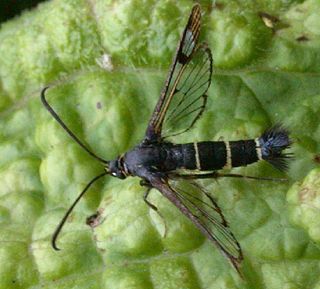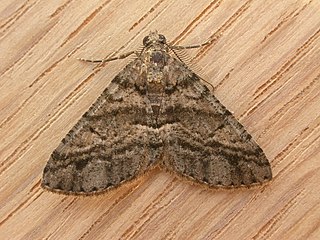
The Sesiidae or clearwing moths are a diurnal moth family in the order Lepidoptera known for their Batesian mimicry in both appearance and behaviour of various Hymenoptera.

Discophlebia lucasii, or Lucas' stub moth, is a moth of the family Oenosandridae first described by Rudolph Rosenstock in 1885. It is found in the south-east quarter of Australia.

Lipogya eutheta, the grey bark moth, is a moth of the family Geometridae first described by Alfred Jefferis Turner in 1917. It is found in the Australian states of Queensland, New South Wales, and Victoria. They have a wingspan around 2.5cm.

Euproctis is a genus of tussock moths in the family Erebidae described by Jacob Hübner in 1819. Species are cosmopolitan, widespread throughout Palearctic, African, Oriental and Australian regions. Molecular phylogenetic studies indicate that the genus as presently understood comprises a large number of unrelated lineages, only a few of which have names, and is therefore in serious need of revision.

Comostola is a genus of moths in the family Geometridae erected by Edward Meyrick in 1888. They are found primarily in Asia and Australia.

Cryphaea is a monotypic moth genus in the family Geometridae. Its single species, Cryphaea xylina, is found in Australia. Both the genus and species were first described by Turner in 1917.

Syneora is a genus of moths in the family Geometridae erected by Alfred Jefferis Turner in 1917. All the species are found in Australia.

Labdia is a genus of moths in the family Cosmopterigidae.

Discophlebia is a genus of moths of the family Oenosandridae first described by Rudolf Felder in 1874.

Erechthias is a genus of the fungus moth family, Tineidae. Therein, it belongs to the subfamily Erechthiinae, of which it is the type genus. The exact circumscription of this genus is still disputed, but it may encompass more than 150 species.

Opogona is a genus of the fungus moth family, Tineidae. Therein, it belongs to the subfamily Hieroxestinae. As it includes Opogona omoscopa, the type species of the now-abolished genus Hieroxestis, it is the type genus of its subfamily.
Discophlebia celaena, the variable stub moth, is a moth of the family Oenosandridae. The species was first described by Alfred Jefferis Turner in 1903. It is found in the south-east quarter of Australia.

The Depressariinae – sometimes spelled "Depressiinae" in error – are a subfamily of moths in the superfamily Gelechioidea. Like their relatives therein, their exact relationships are not yet very well resolved. It has been considered part of family Elachistidae sensu lato or included in an expanded Oecophoridae. In modern classifications they are treated as the distinct gelechioid family Depressariidae.

The Oecophorinae are the nominate subfamily of moths in the concealer moth family (Oecophoridae). They are part of the insufficiently studied superfamily Gelechioidea, and like their relatives, the circumscription of this taxon is disputed.

Xyloryctidae is a family of moths contained within the superfamily Gelechioidea described by Edward Meyrick in 1890. Most genera are found in the Indo-Australian region. While many of these moths are tiny, some members of the family grow to a wingspan of up to 66 mm, making them giants among the micromoths.

Pedois is a genus of moths of the family Depressariidae.

Eretmocera is a genus of moths in the family Scythrididae.
This page is based on this
Wikipedia article Text is available under the
CC BY-SA 4.0 license; additional terms may apply.
Images, videos and audio are available under their respective licenses.















